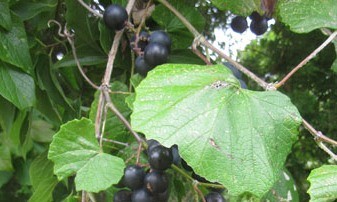Fox grape
(Ampelocissus tomentosa)

Description
Vitis labrusca, the fox grape, is a species of grapevines belonging to the Vitis genus in the flowering plant family Vitaceae. The vines are native to eastern North America and are the source of many grape cultivars, including Catawba, Concord, Delaware, Isabella, Niagara, and many hybrid grape varieties such as Agawam, Alexander and Onaka. Among the characteristics of this vine species in contrast to the European wine grape Vitis vinifera are its "slip-skin" that allows the skin of the grape berries to easily slip off when squeezed, instead of crushing the pulp, and the presence of tendrils on every node of the cane. Another contrast with European vinifera is the characteristic "foxy" musk of V. labrusca, best known to most people through the Concord grape. This musk is not related to the mammalian fox, but rather to the strong, earthy aromas characteristic of the grapes that were known by early European-American settlers in the New World. The term "foxy" became a sort of catchall for the wine tasting descriptors used for these American wines that were distinct from the familiar flavors of the European viniferous wines. According to wine historian Edward Hyams and wine expert Jancis Robinson, Vitis labrusca was probably the species seen by Leif Ericsson growing wild along the coast of Vinland in the 11th century. There is ample evidence that the labrusca was growing wild in North America before Europeans arrived. The vine was not officially identified and recorded until Carl Linnaeus and his peers started cataloging American vine species in the mid-18th century. In the 19th century, Vitis labrusca was among the American vines transported to Europe that were carrying the phylloxera louse that caused widespread devastation to the European vineyards planted with Vitis vinifera. Also in the 19th century, Ephraim Bull of Concord, Massachusetts, cultivated seeds from wild labrusca vines to create the Concord grape which would become an important agricultural crop in the United States. Vitis (grapevines) is a genus of 79 accepted species of vining plants in the flowering plant family Vitaceae. The genus is made up of species predominantly from the Northern Hemisphere. It is economically important as the source of grapes, both for direct consumption of the fruit and for fermentation to produce wine. The study and cultivation of grapevines is called viticulture.
Taxonomic tree:







